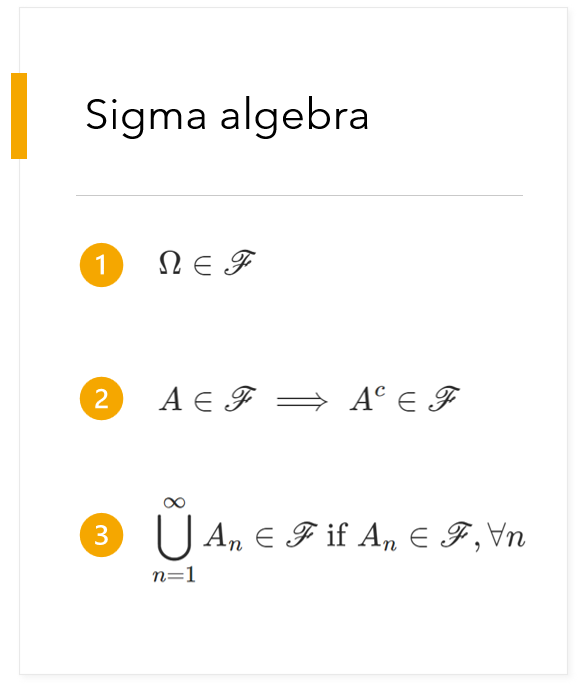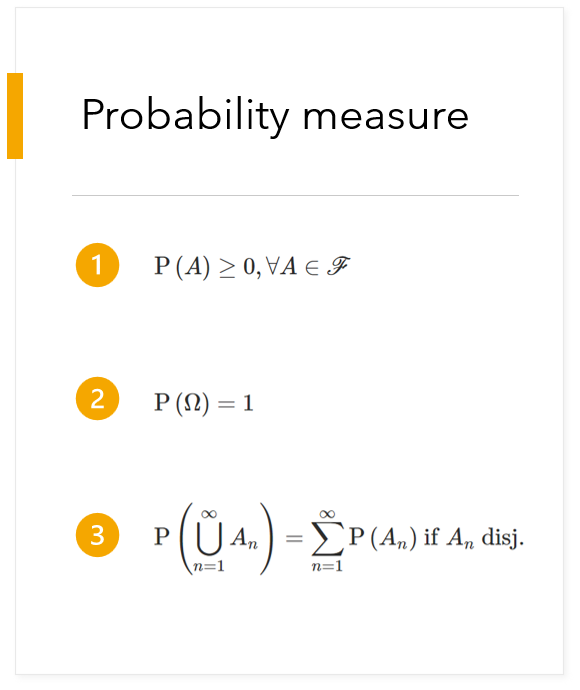A probability space is a triple
,
where
is a sample space,
is a sigma-algebra of events and
is a probability measure on
.
The three building blocks of a probability space can be described as follows:
the sample space
is the set of all possible outcomes of a probabilistic experiment;
the sigma-algebra
is the collection of all subsets of
to which we are able/willing to assign
probabilities; these
subsets are called events;
the probability measure
is a function that associates a probability to each of the events belonging to
the sigma-algebra
.
Suppose that the probabilistic experiment consists in extracting a ball from
an urn containing two balls, one red
()
and one blue
(
).
The sample space
is
A possible sigma-algebra of events
iswhere
is the empty set.
The four events could be described as follows:
:
nothing happens;
:
either a blue ball or a red ball is extracted;
:
a red ball is extracted;
:
a blue ball is extracted.
A possible probability measure
on
is
![[eq4]](/images/probability-space__22.png)
Another possibility would be to define the so-called trivial
sigma-algebraand
specify a probability measure
on
as
![[eq7]](/images/probability-space__26.png)
How are the three building blocks of a probability space defined?
The first one, the sample space
,
is a primitive concept, loosely defined as the set of all possible outcomes of
the probabilistic experiment.
The other two building blocks are instead defined rigorously, by enumerating the properties (or axioms) that they need to satisfy.
Let
be a set whose elements are subsets of
.
Then,
is a sigma-algebra if and only if it satisfies the following axioms:
;
If
,
then
(where
is the complement of
,
also denoted by
)
If
is a countable collection of elements of
and
,
then
.
It is possible to prove that these axioms imply:
;
If
is a countable collection of elements of
and
,
then
.
Let
be a function that associates a real number to each element of the
sigma-algebra
.
Then,
is a probability measure if and only if it satisfies the following axioms:
If
,
then
;
;
If
is a countable collection of disjoint elements of
(i.e.,
if
),
then
![]() .
.
Why do we impose all these axioms?
Basically, it is for historical reasons and mathematical convenience.
Before Andrey Kolmogorov used the axioms above to define probability, mathematicians had proposed other definitions of probability. Those definitions had several flaws, but they all implied that probability satisfies the axioms above.
By using the axioms as a definition, Kolmogorov was able to develop a theory of probabilities that was logically coherent and without mathematical flaws.
Since then, this definition has been productively used by generations of statisticians, who have built myriads of incredibly useful results upon Kolmogorov's theory.
If it is the first time that you see these axioms, the best strategy to approach them is to memorize them and then convince yourself that they are reasonable. The next sections will help you to do so.
Let us start from sigma-algebras.
As we have said, the sigma-algebra contains all the subsets of
to which we wish to assign probabilities.
So, the first thing to keep in mind is that we do not necessarily need to
assign a probability to each possible subset of
.
Example
Suppose that the sample space is the unit
interval:Define
![]() You
can easily check that
You
can easily check that
is a sigma-algebra, by verifying that it satisfies the three axioms. It
contains very few subsets of
.
However, if we are interested in the probability of the event
,
we do not need anything more complicated. Clearly, we can build more complex
sigma-algebras. For example, the smallest sigma-algebra that contains the
interval
is
![]() A
widely used sigma-algebra is the
Borel one, which
contains all the open subintervals of
A
widely used sigma-algebra is the
Borel one, which
contains all the open subintervals of
.
Let us now turn to the three defining axioms.

Axiom 1 means that we should always be allowed to speak of the trivial event "something will happen".
According to Axiom 2, if we take into consideration the possibility that one
of the things in the set
will
happen, then we must also consider the alternative possibility that none of
the things in the set
will happen.
According to Axiom 3, if we contemplate the possibility that some events will happen (separately for each of them), then we must also be able to assess the possibility that at least one of them will happen (their union).
Axiom 3 is formulated for countable collections of events for mathematical convenience. However, it implies that an analogous property holds for finite collections of events.
In fact, by setting
we
obtain
As we have said, a probability measure attaches a real number (a probability) to each event in the sigma-algebra.

Axioms 1 and 2 are established arbitrarily: we simply decide, in line with a centuries-old tradition, that a probability is a positive number smaller than or equal to 1, and that the probability of the sure event is 1.
According to Axiom 3 (called countable additivity), the sum of the probabilities of some disjoint events must be equal to the probability that at least one of those events will happen (their union).
The countable additivity axiom is probably easier to interpret when we set
so
as to obtain
![[eq26]](/images/probability-space__72.png) which,
for
which,
for
,
becomes
![]()
The lecture on the mathematics of probability contains a more detailed explanation of the concept of probability space and of the properties that must be satisfied by its building blocks.
Previous entry: Probability mass function
Next entry: Random matrix
Please cite as:
Taboga, Marco (2021). "Probability space", Lectures on probability theory and mathematical statistics. Kindle Direct Publishing. Online appendix. https://www.statlect.com/glossary/probability-space.
Most of the learning materials found on this website are now available in a traditional textbook format.